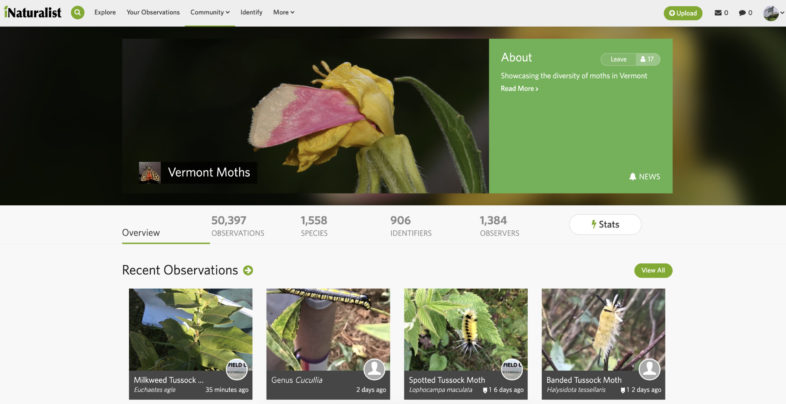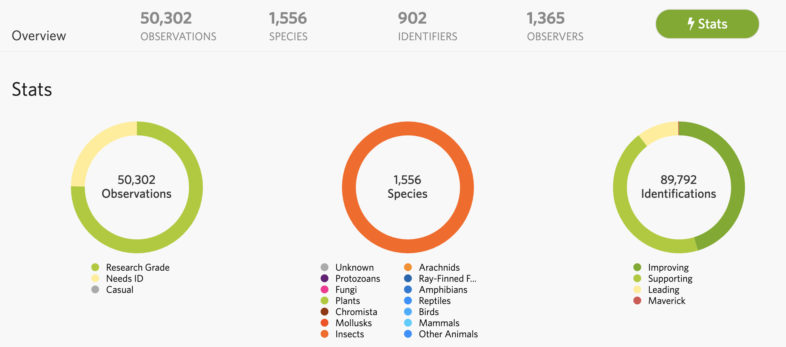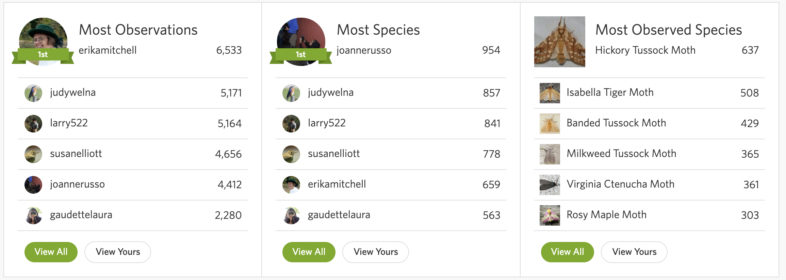
There’s a new collection project that automatically gathers and presents all of Vermont moth data from iNaturalist in one easy place – Vermont Moths on iNaturalist. If you put a moth record in the Vermont Atlas of Life project on iNaturalist, or anywhere in iNaturalist – Vermont Moths will tally it.
The Vermont Atlas of Life, with the aid of many volunteers across Vermont, has been mapping moth distribution and phenology one photo-observation at a time. Since 2013, biologists and naturalists have contributed moth observations to the Vermont Atlas of Life on iNaturalist. Many of us turn on special lights in our backyards on summer nights to find hundreds of moths and other insects gathering on white sheets, hunt fields and forest for day-flying moths, and place rotten fruit bait out to attract other moths. Many of these moths can be identified from good photographs (although some are impossible without dissection and examination under a microscope). With today’s amazing digital photography technology, coupled with the newer Peterson’s Field Guide to Northeastern Moths and web sites like iNaturalist, BugGuide, Moth Photographers Group, or Moths of Eastern North America Facebook Group, moth watching (aka mothing) has become increasingly popular.
Two amazing naturalists, Laura Gaudette and JoAnne Russo, have become moth fanatics and experts over the years and have been leading the charge here in Vermont in documenting moths and encouraging others. Earlier this year, they created a collection project that automatically gathers and presents all Vermont moth data from iNaturalist in one easy place – Vermont Moths on iNaturalist. If you put a moth record in the Vermont Atlas of Life project on iNaturalist, or anywhere in iNaturalist – Vermont Moths will tally it.
Over the past few years, 1,365 moth watchers here in Vermont have added over 100 new species to the Vermont checklist via iNaturalist and have documented 1,556 species across the state so far. What’s even more amazing is that we’ve recorded over 50,000 observations (and quickly growing), which helps us understand their phenology, habitat use, and range in Vermont like never before.

Vermont Moth stats from iNaturalist as of September 18. Click on the image to see the latest stats at Vermont Moths on iNaturalist.
Since the 1995 landmark publication Moths and Butterflies of Vermont: A Faunal Checklist, nearly 400 new moth species have been found in Vermont thanks to the tireless efforts of both professional and amateur lepidopterists (we’re updating the faunal checklist of moths now). Preliminary results show that there are now over 2,200 species of moths known in Vermont. And, there are likely many more awaiting our discovery.
We encourage you to add your photographs of moths, too. Finding moths can be as simple as looking for them flying about during the day, or leaving a porch light on and checking it after dark. Serious moth aficionados use special lights and baits to attract them. Check out this short introduction on how to start mothing. It’s easy and fun!
We invite you to join the Vermont Atlas of Life and the Vermont Moth collection project on iNaturalist and contribute your observations too. Or just visit to see what are the top observed species, who has the most observations or the most species. Also check out the map to find areas that are under-reported. Vermont has an incredible diversity of moths and an incredible group of iNaturalist citizen scientists!


Great work……….